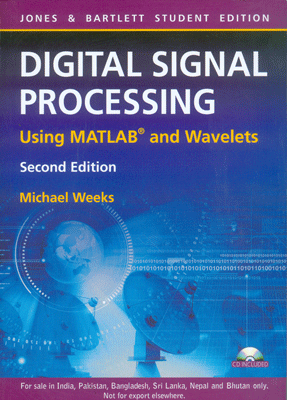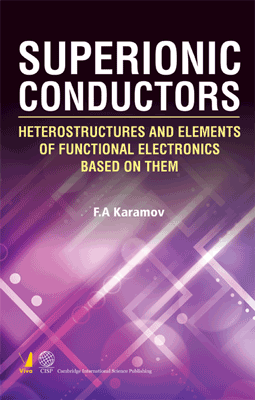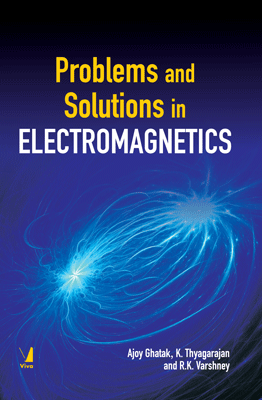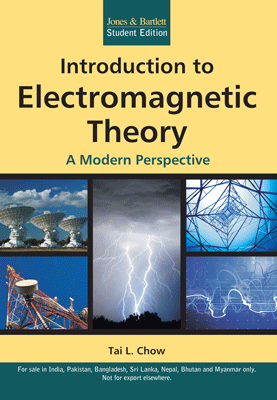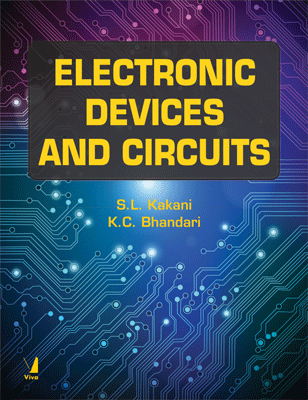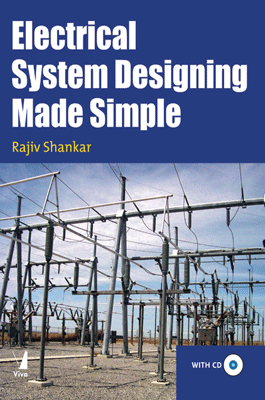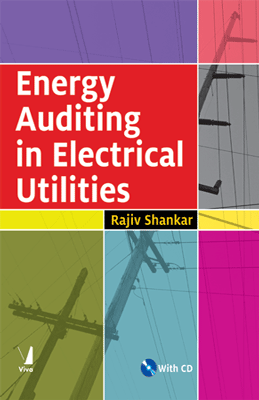Digital Signal Processing Using MATLAB and Wavelets, 2/e (With CD)
Digital Signal Processing Using MATLAB and Wavelets, 2/e (With CD)
₹625.50 ₹695.00 Save: ₹69.50 (10%)
Go to cartISBN: 9789380853673
Bind: Paperback
Year: 2015
Pages: 512
Size: 165 x 235 mm
Publisher: Jones & Bartlett Learning
Published in India by: Jones & Bartlett India
Exclusive Distributors: Viva Books
Sales Territory: India, Nepal, Pakistan, Bangladesh, Sri Lanka, Bhutan
Description:
Designed for upper division engineering and computer science students as well as practicing engineers and scientists, this book emphasizes the practical applications of signal processing. Over 100 MATLAB examples and wavelet techniques provide the latest applications of DSP, including image processing, games, filters, transforms, networking, parallel processing, and sound.
This Second Edition also provides the mathematical processes and techniques needed to ensure an understanding of DSP theory. Designed to be incremental in difficulty, the book will benefit readers who are unfamiliar with complex mathematical topics or those limited in programming experience. Beginning with an introduction to MATLAB programming, it moves through filters, sinusoids, sampling, the Fourier transform, the z-transform and other key topics. Two chapters are dedicated to the discussion of wavelets and their applications. A CD-ROM (platform independent) accompanies every new printed copy of the book and contains source code, projects for each chapter, and the figures from the book.
Key Features:
- Covers modern applications such as edge detection, audio, and image compression
- Includes a new chapter on the continuous wavelet transform
- Includes a separate chapter on MATLAB programming (Chapter 2)
- Designed for the reader who does not have extensive math and programming experience
- Companion CD-ROM has MATLAB projects for each chapter with over 100 MATLAB examples, source code (.m files), and figures from the book
- Instructor's resources include a CD-ROM with solutions, all the code (.m-files), figures from the book, and over 360 MicrosoftPowerPoint slides
Target Audience:
Designed for upper division engineering and computer science students as well as practicing engineers and scientists, this book emphasizes the practical applications of signal processing.
Contents:
Chapter 1: Introduction • Numbers • Why Do We Use a Base 10 Number System? • Why Do Computers Use Binary? • Why Do Programmers Sometimes Use Base 16 (Hexadecimal)? • Other Number Concepts • Converting Between Representations • Converting Binary to Decimal • Converting Decimal to Binary • Floating-Point Storage • Complex Numbers • What Is a Signal? • Analog Versus Digital • What Is a System? • What Is a Transform? • The Plus/Minus Transform • Working with Sinusoids • Plotting Sinusoids • Sampling Real Signals • Time and Frequency • Summations
Chapter 2: MATLAB • Working with Variables • Getting Help and Writing Comments • MATLAB Programming Basics • Scalars, Vectors, and Matrices • Number Ranges • Output • Conditional Statements (if) • Loops • Continuing a Line • Arithmetic Examples • Functions • How NOT to Plot a Sinusoid • Plotting a Sinusoid • Plotting Sinusoids a Little at a Time • Calculating Error • Sometimes 0 Is Not Exactly 0 • Comparing Numbers with a Tolerance • Rounding and Truncating • MATLAB Programming Tips • MATLAB Programming Exercises • Other Useful MATLAB Commands
Chapter 3: Filters • Parts of a Filter • FIR Filter Structures • Causality, Linearity, and Time-Invariance • Multiply Accumulate Cells • Frequency Response of Filters • IIR Filters • Trends of a Simple IIR Filter • Correlation • A Concise Expression for an Approximate Correlation Value • Finding Cross-Covariance as a Simple Correlation Example • Correlation Examples • Cross-Correlation • Concerning the Shift of a Signal • A Cross-Correlation Program
Chapter 4: Sinusoids • Review of Geometry and Trigonometry • The Number p • Unit Circles • Principal Value of the Phase Shift • Amplitudes • Reviewing Complex Numbers • Some Interesting Properties of j • Rotating Counterclockwise • Rotating Clockwise • Removing j from v-a • Where Does e Come from? • Euler's Formula • Alternate Form of Euler's Equation • Euler's Inverse Formula • Manipulating Complex Numbers • Adding Two Complex Numbers • Adding Complex Numbers in General • Adding Rotating Phasors • Adding Sinusoids of the Same Frequency • Multiplying Complex Numbers • Adding Rotating Phasors: An Example • Multiplying Phasors • Harmonic Signals • Representing a Digital Signal as a Sum of Sinusoids • Spectrum
Chapter 5: Sampling • Sampling • Reconstruction • Sampling and High-Frequency Noise • Aliasing • Aliasing Example • Folding • Locations of Replications After Sampling • Nyquist Rate • Bandpass Sampling
Chapter 6: The Fourier Transform • Fast Fourier Transform Versus the Discrete Fourier Transform • The Discrete Fourier Transform • Plotting the Spectrum • Zero Padding • DFT Shifting Theory • The Inverse Discrete Fourier Transform • Forward and Inverse DFT • Leakage • Harmonics and Fourier Transform • Sampling Frequency and the Spectrum • Understanding the DFT • When Analysis Matches the Actual Frequency • When Analysis Does Not Match the Actual Frequency • One More Detail • Showing the DFT as Angles on Unit Vector Graphs • Finding the Forward and Inverse DFT as Matrix Operations • A Program for Finding the DFT as Matrix Operations
Chapter 7: The z-Transform • The z-Transform • Replacing Two FIR Filters in Series • Revisiting Sequential Filter Combination with z • Why Is z-1 the Same as a Delay by One Unit? • How the z-Transform Reduces to the Fourier Transform • Powers of -z • Showing that Time-Domain Convolution Is Equivalent to Frequency-Domain Multiplication • Frequency Response of Filters • Trends of a Simple IIR Filter, Part II
Chapter 8: The Discrete Wavelet Transform • The Two-Channel Filter Bank • Quadrature Mirror Filters and Conjugate Quadrature Filters • How the Haar Transform Is a 450 Rotation • How The Haar Transform Affects a Point's Radius • How The Haar Transform Affects a Point's Angle • Daubechies Four-Coefficient Wavelet • Down-Sampling and Up-Sampling • Example Using Down-/Up-Samplers • Down-Sampling and Up-Sampling with Two Coefficients • Down-Sampling and Up-Sampling with Daubechies • Breaking a Signal Into Waves • Wavelet Filter Design???Filters with Four Coefficients • Orthonormal Bases • Multiresolution • Biorthogonal Wavelets • Wavelet Transform Theory • Performing the DWT with Matrices • A Brief Review of Matrix Multiplication • Applying the DWT • Down-Sampling with Matrices • Combining Lowpass and Highpass into One Matrix • Generalizing the DWT with Matrices • Frequency Magnitude Response for a Wavelet
Chapter 9: The Continuous Wavelet Transform • The Mexican Hat Wavelet • Shifting the Hat • Scaling the Hat • Shifting and Scaling: Wavelets • Evaluating Integrals • Multiplying a Function by the Mexican Hat • Example of the CWT • Analytical Example of the CWT on a Function • Analytical Example of the CWT on an Impulse Function • The CWT on a Square Function • A Program to Compute the CWT • Convolution • Another Way to Approach the CWT Function • Undoing the Continuous Wavelet Transform
Chapter 10: Applications • Examples of Working with Sound • Examples of Working with Images • Shrinking a Picture • A Bottom-Up Approach • Abstracting One Level Up • Batch Processing • Using the Smaller Images in a Web Page • Performing the Two-Dimensional Discrete Wavelet Transform on an Image • Two-Dimensional DWT of a Grayscale Image • Two-Dimensional DWT of a Color Image • Doing and Undoing the Discrete Wavelet Transform • Edge Detection • Recursively Solving a Sudoku Puzzle • Frequency Magnitude Response of Sound • Filter Design • Windowing Methods • Designing an FIR Filter • Compression • Experimenting with Compression • Compressing an Image Ourselves
A. Constants and Variables Used in This Book • Constants • Variables • Symbols Common in DSP Literature
B. Equations • Convolution • Correlation • Euler's Formula • Fourier Transform • Continuous Fourier Transform • Discrete Fourier Transform • Inverse Discrete Fourier Transform • Magnitudes, Phases, and Analysis Frequencies • Integral Approximation • Sampling • Statistics • Trigonometric Identities and Other Math Notes • Wavelet Transform • Discrete Wavelet Transform • Continuous Wavelet Transform • z-Transform • DSP Project Ideas • About the CD-ROM • Answers to Selected Exercises • Glossary • References • Index
About the Author:
Michael Weeks-Georgia State University
Michael Weeks is an associate professor at Georgia State University where he teaches courses in Digital Signal Processing. He holds a PhD in computer engineering from University of Louisiana and has authored or co-authored numerous journal and conference papers.
